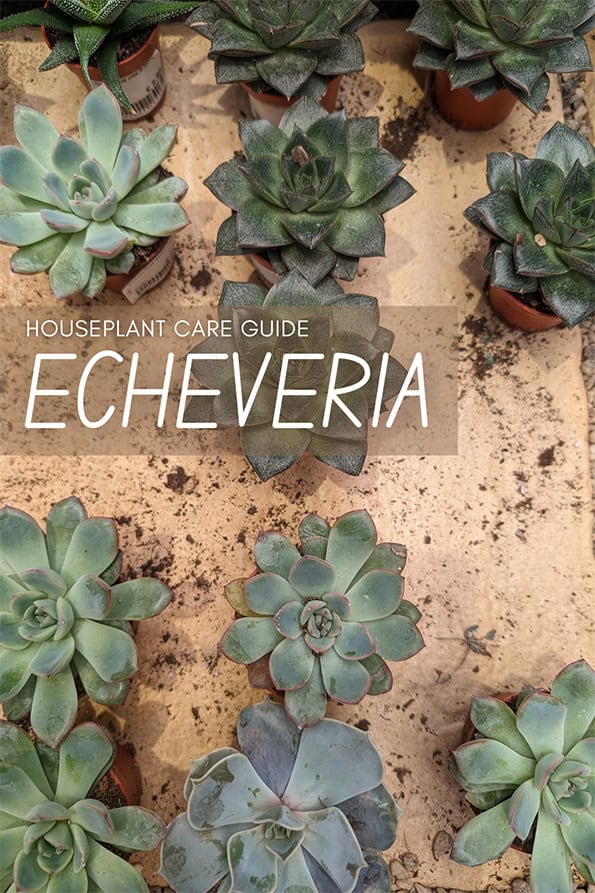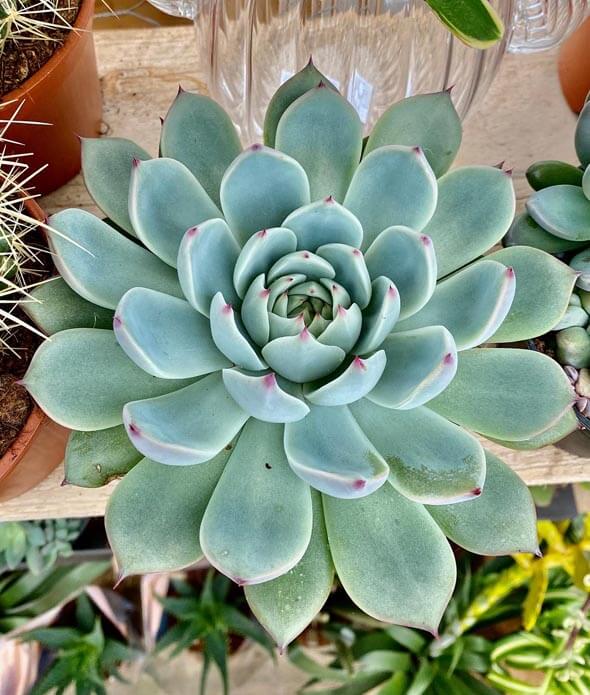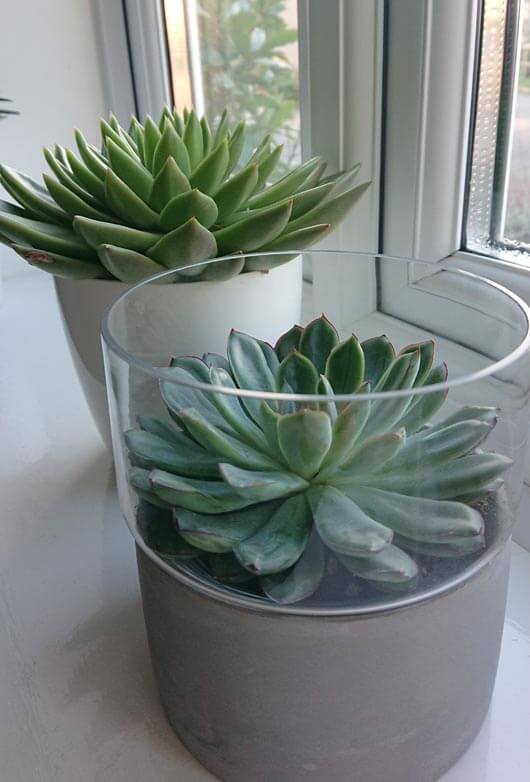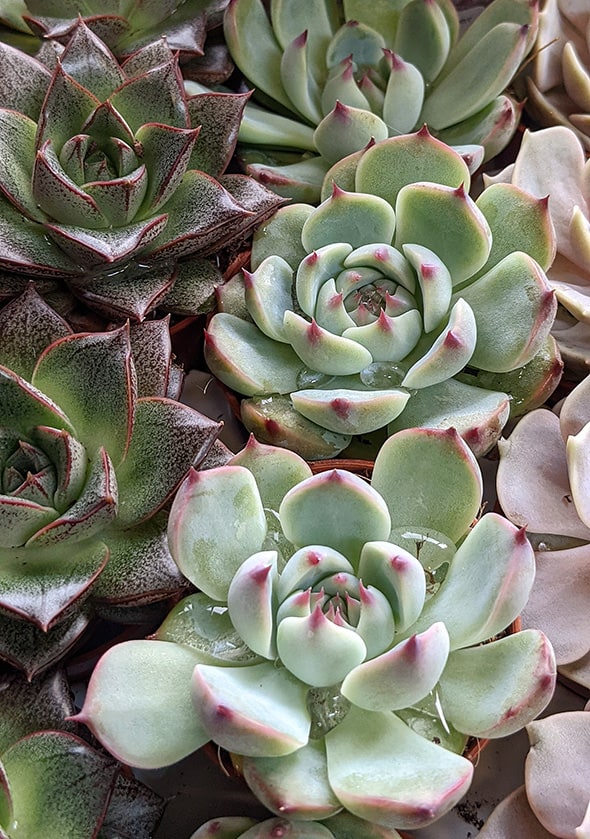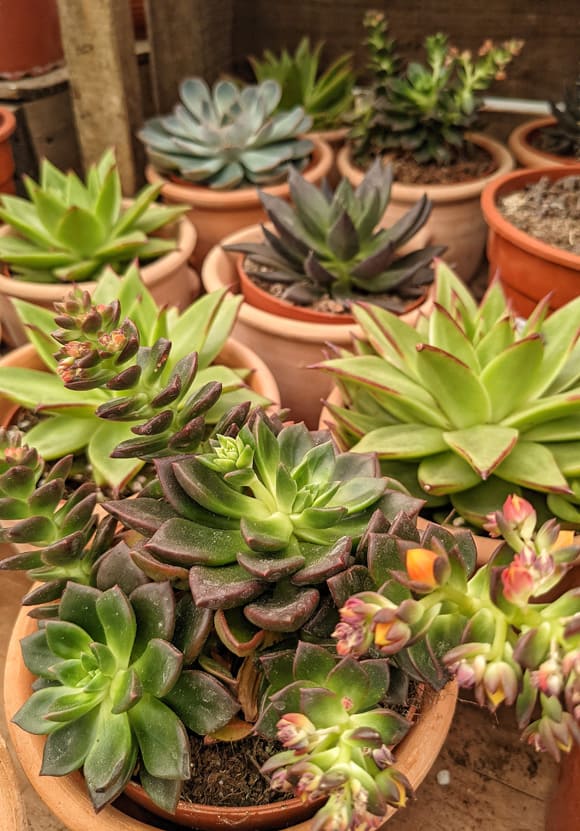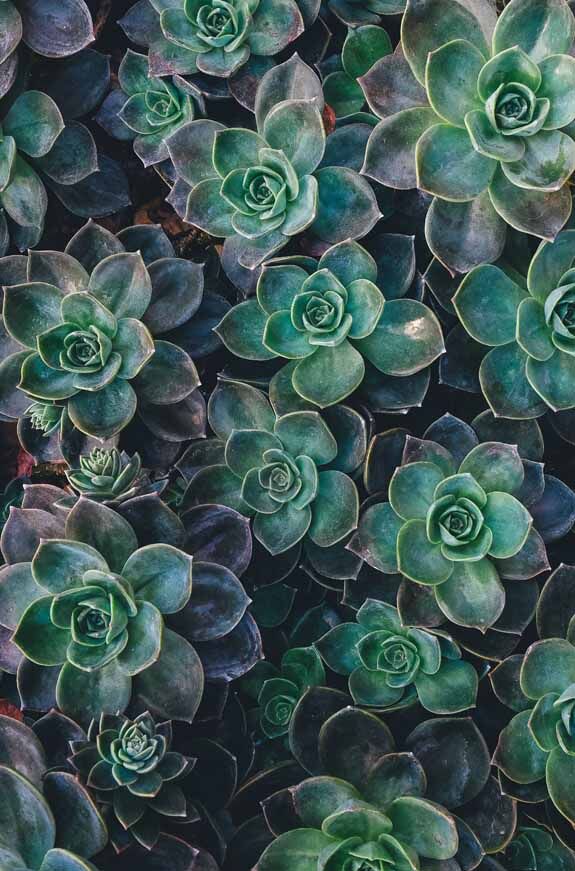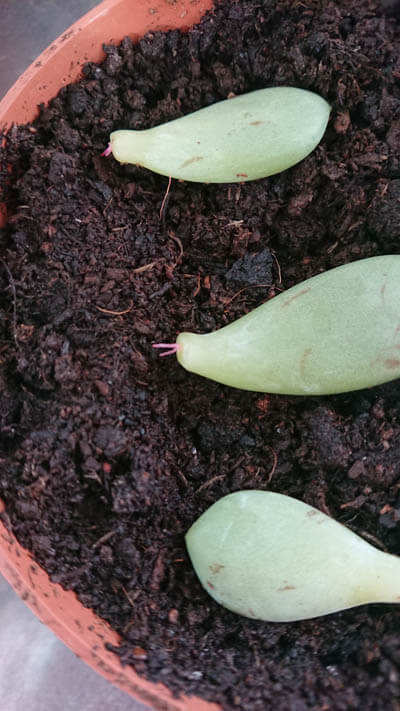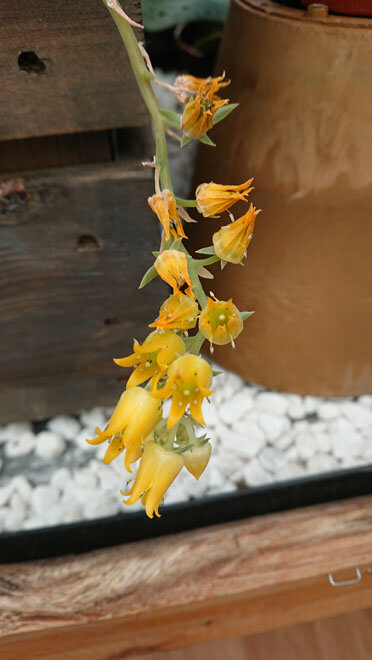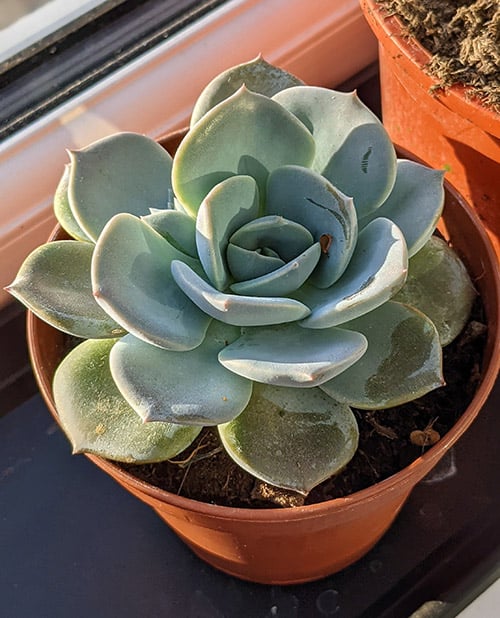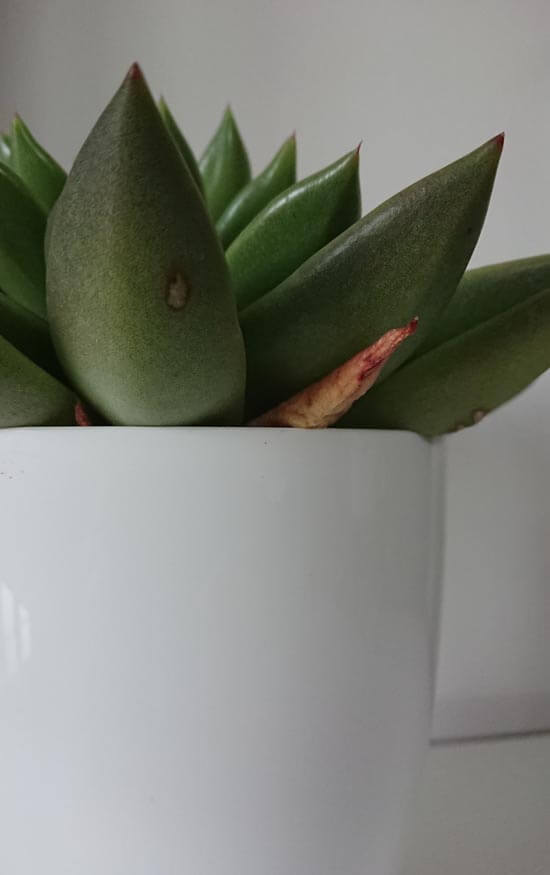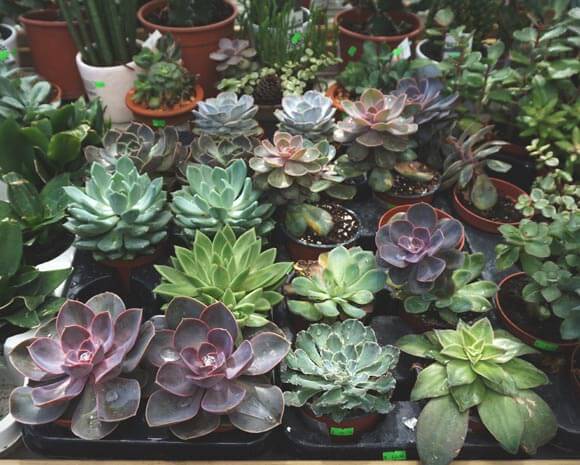Echeveria succulents are fairly common outdoors, but in the last few years, they've become trendy modern indoor houseplants.
Although native to semi-desert areas of Central America, Mexico and northwestern South America, they do remarkably well as indoor plants. Like many other small succulents, it's common to find them being grown in unusual and visually arty containers. You can also grow several in a dish garden for a more impactful display.
Beautiful plump leaves will grow from the central small rosette of an echeveria succulent, creating eye catching leaf symmetry.
The Echeveria is a fairly small houseplant but is still robust and easy going. You can forget to water them for a month and they'll not be too grumpy about it. In fact they'll take periods of neglect as a personal challenge.
Although to really make them shine, you need to care for them properly and I've put together a complete Echeveria care guide below to teach you what to do.
The leaves come in many colors, from plain greens to really showy colors. These leaves grow to form a rosette shape that hardly changes during its whole life.
The rosette formation allows for maximum exposure to sources of light while allowing the plants to capture and direct water down towards the roots efficiently.
How do you pronounce Echeveria correctly? Say:
eh-cheh-VEH-ree-uh
They have a few common names such as Ghost Echeveria or Hens and Chicks. Do be careful with the Hens and Chicks name. This is a common name that Sempervivum or houseleaks will usually go by too.
Mislabeling and confusion is common. Echeveria and Sempervivum are both within the Crassulaceae family, so while they have traits and looks in common, they're grown differently and have separate care needs.
Sempervivum is cold hardy so is almost always grown as an outdoor plant in rock gardens. In comparison, Echeveria struggles in cold temperatures. Additionally, Sempervivum will wither and go over after flowering, whereas a well cared for Echeveria will flower year after year.
TIP - You might find some very young offsets being sold, and these will be cheaper. Have a look around to see if you can find a mature one being sold so you can get an idea of the ultimate size.
It's usual to find these plants in semi adult form or at full maturity. Hybrids can be a little more pricey than your run of the mill Echeveria, but even then the cost is still usually on the lower scale when compared to houseplants in general.
In all cases, before buying make sure you have a good look at the plant and check for any signs of rotting around the base and in the rosette itself.
Once rot sets in these plants can quickly fall apart and turn to mush, so don't get a dud with the hope it will recover once you get it home.
Overhead photo of an Echeveria houseplant. There is one thing these plants do better than almost any other out there, and that's leaf symmetry. New growth will open from the center like a fan opening up.
There are lots of varieties to choose from. If you're interested in the range or trying to identify what you have, skip to the bottom of this post where I cover some of the more popular types.

Hi, I'm Tom!
If you're like me and enjoy the challenge of growing houseplants and getting them to thrive, then Ourhouseplants can help. This website shares my knowledge and years of growing plants and provides (hopefully) helpful advice on properly caring for your indoor plant friends.
TIP - Leaf damage from sunburn will not heal and because they grow slowly and keep hold of their leaves for long periods, the burn damage will be there for a long time too.
Almost all Echeveria plants love bright light with some sunlight. Go for a sunny window whenever you can.
They will always struggle in low light conditions so avoid these spots. If you can't, then you'll need a grow light.
Direct, intense sunlight can harm plants not used to the intensity. Insufficient water can also contribute to the leaves being more susceptible to sun damage.
Window ledges are often a perfect location for these plants, but if going for one that has a southern exposure, try to shield it, and if you notice any damage, move it immediately.
Echeveria (E. agavoide "Miranda" and E. lilacina) growing happily on a window ledge in full sun.
Out in their natural habitat many succulents are adapted to heavy downpours and then a fairly long period before the next lot of rain. Their physical traits such as the thick fleshy leaves and the way they direct water directly down to the roots all help with this.
Echeveria like a good deep through watering occasionally then a wait until they dry out completely. They aren't cacti though, so they shouldn't be deprived of water for excessive periods. As a rough guide I treat mine as follows:
Shriveling leaves is often a sign of underwatering, but it can also be a sign of overwatering. I have a more detailed post that walks you through this topic.
I will stress that overwatering is the biggest problem with these plants. It's by far the most common reason people lose these plants when growing them indoors. So take care.
Although I have also written a full guide about saving overwatered succulents, I would say Echeveria plants are one of the hardest to save even if the overwatering is classed as "moderate".
Lots of people will recommend you don't, but it's absolutely fine to water them from above and through the center of the plant.
The primary reason for thinking this is a "bad thing" is that if water sits in the rosette and it gets cool or very humid, this water would sit there for hours, potentially days, and risk the central part of the plant rotting away.
Echeveria plants watered from above with water drops resting on the leaves.
This is generally rubbish. Unless you're growing them in a terrarium or very humid spot, it's unlikely to be a problem. If you want to find out why check out my "Is it safe to water houseplants at night" post.
Although they're easy houseplants, they're not tropical plants. Their greatest weakness indoors is the lack of good ventilation combined with humid conditions and wet potting soil. These conditions will quickly increase the possibility of your plant rotting.
Try to choose a location that has some natural airflow, so near a window. But be careful about growing them in constantly steamy locations like a bathroom or kitchen.
Although these are small plants with slow growth rates, it might be surprising to know that they do respond well to feeding.
A normal liquid houseplant fertilizer that's been diluted by half every month or every other month is OK. If you're feeling fancy, a specially formulated Cactus / Succulent feed is ideal.
Lots of different Echeverias for sale in a plant store.
This plant adores warmth. They'll easily cope with the hottest rooms in your home. On the other hand they can literally fall apart and turn to mush overnight if exposed to frosts or near sub-zero temperatures.
To be safe I'd suggest not letting the temperature ever go below 5°C (41°F).
The adult plant will rarely outgrow it's existing containe. So unless you're starting out with a young plant that is rapidly growing you may not need to think about repotting.
The growth habit of the Echeveria is to spread out by creating offsets around the main plant's edges which you can remove to create more plants. If you want to allow it to develop offsets and spread out instead, then you'll need to consider repotting from time to time and making sure the container is wider than the last one.
They don't have extensive root systems so don't need a deep container. This is one succulent that will grow well in a small pot.
Going larger and picking a big container will increase the possibility of accidental overwatering and subsequent root rot setting in. Your best bet is to choose a shallow and wide pot rather than deep and narrow.
When picking the soil, a standard all purpose potting mix with added grit for drainage or a cacti mix is needed
When picking the potting soil, a standard all purpose potting mix with added grit (or something similar) for drainage or a cacti mix containing sandy soil is needed. I have a guide which teaches you more about good succulent mixes here.
Good drainage created by well-draining soil is essential as this will help aerate the soil and give the roots space to grow and prevent them from becoming trapped in tight, closed soils.
Another great trait of this plant is how easy it is to propagate by removing the constant supply of offsets that it generates over time. They also have a fantastic rate of success when propagating through leaf cuttings if you'd rather do it this way.
Echeveria with multiple offsets like this can be separated to create new plants - Photo by Annie Spratt
Offsets Propagation.
If your plant is being well looked after and you've had it a while (and the pot is big enough) you will quickly find it produces small offsets to the sides.
If you want to remove them to create additional plants, wait until they're a reasonable size that lets you handle them without damaging them too much.
You may need to gently take the adult plant out of the pot and use your hands to tease the offsets away. They should separate relatively easily though. Try to take the offset with some of its own roots as this will give it an advantage and help it to establish much faster.
Once separated it's just a case of planting it up in its own pot with a similar potting mix as it was growing in previously. Don't cover it with a plastic bag or anything like that as the increased humidity could encourage fungi to grow and cause the offset to rot.
Leaf Cutting Propagation - Method One.
Using healthy leaves pulled from the mother plant, push them gently into moist fresh compost / potting mix.
People in general, will suggest letting the leaf ends dry for 24 hours before planting them into the mix. However I've honestly not found this increases / decreases the chances of the cuttings "taking".
It's important you're not using yellowing or rotting leaves from an ailing plant, as they're likely too far gone and won't work.
Leaf Cutting Propagation - Method Two.
Until you actually try this method, you might think it's utterly crazy. I was amazed the first time I tried it and even today I still partly think "this will never work", however it almost always does and quite quickly.
All you need to get started is a moist pot of fresh compost / potting mix, and some healthy leaves.
Then just lay the leaf on the potting mix as shown in the photo below, you can put several in one pot if preferred.
Although slower, leaf cuttings take easily and are a very reliable way to get new plants
Then keep the potting mix moist and after a week or so you might notice small "roots" forming at the end which was attached to the plant (see those tiny pink shoots in the photo above). These will grow down into the potting mix and within a few months, new leaves will start to grow.
Young offsets and plants being grown from leaf cuttings can get quite a growth spurt on when starting out. But mature plants change very slowly, even in optimal conditions. Outside of the growing season, when temperatures drop, they often go dormant with no growth.
Compared to other indoor plants, Echeveria are almost always small houseplants in regard to their heights, growing no taller than around 30 cm (12 in).
Although they can spread out quite far because of the offsets a mature plant will eventually start producing, this can look like a living bouquet of succulent rosettes.
After a few years, once they've reached maturity, these plants will flower yearly if they're being well looked after. Usually this will happen during the middle of summer.
A long, slender stem (sometimes two), called an inflorescence will grow rapidly from near the center of the plant and at the top you will see a number of small flowers that dangle on the end like bells.
They can sometimes smell a little bit if you get close and the flowers can come in several different colors. The bell like blooms won't last more than a few weeks, and when it all shrivels up you can cut the flowering stem off.
A well cared for Echeveria plant will produce blooms each year. You can remove the flower stalks once the blooms have faded.
There is no toxicity danger for cats, dogs or people, so yes they're safe to have around pets. The thick chunky nature of the leaves can make the plant look a little like a toy though, so if your pet is the playful type then situate it somewhere out of reach.
As houseplants, Echeveria can live in your home quite happily for many years. Given time though the plants will lose some of their oldest leaves or start to look a bit "leggy".
It's the compact nature of these plants that are desirable so an old specimen might not be as attractive as it once was. When this happens think about propagating, that way you can create a brand new plant from an existing friend and start over.
Plant is rotting / lots of leaves falling off.
There are two main reasons the leaves on an Echeveria fall off. Either cold damage, so being left in too cold of a place over winter or overwatering.
Lots of leaves going "funny" and falling off at the bottom is a strong indication of too much water being given.
Unfortunately overwatering is very common with these plants. It's how I've lost all of mine over the years. If there is one thing I've learned it's that they don't need regular heavy watering to do well and if you water too frequently it will cause rot to set in pretty fast.
Really ration the water, and to be extra safe, let the soil dry out completely before you water it again. The plant in the photo above has early signs of the wrong type of watering (mushy leaves at the base). If the owner doesn't start cutting back they'll lose the entire plant.
Further reading -
Am I Overwatering my houseplants?
How To Save an Overwatered Succulent
Plant is growing taller / stretched / leggy.
Obviously, a little growth upwards is what you want, good even. But when it starts to get out of control you've got an issue. Namely too little light.
If not enough light is provided the plant will "stretch" out and become lanky and spindly.
If you notice this happening, move it to a brighter place to stop it getting worse. Don't be too hasty to plonk it down on a sunny windowsill though. Make sure you avoid direct sunlight for a few weeks while your plant gets used to the higher light intensity.
Shriveling / Wrinkling leaves.
Leaves that are shriveling could be one of three things. Overwatering or Underwatering (a helpful and conclusive answer we know!) is the most likely.
In most cases wrinkling leaves are usually a sign of underwatering, but you'll have to carry out one final check yourself and feel the soil. If it's bone dry, then you can be reasonably certain the plant has fully dried out and needs to be watered urgently.
If the soil is damp or wet then there is a good chance overwatering has occurred and rot is starting to set in. Assess the damage by trying to look at the plant's roots, if they're mush then the main plant might not be far behind.
Consider propagating some of the healthy leaves to create new plants. If the roots are fine wait a few weeks for the soil to dry out before watering again.
The third and final explanation could be down to aged leaves. The lower leaves will eventually start to look a bit rubbish and will fall off, a bit of winkling is often the first sign.
Brown leaves.
The older leaves at the base of the plant will go yellow in time and this is natural. They crisp up before shriveling and turning totally brown (see photo below).
You can remove them at this stage, but they can cling on quite tightly so be careful and avoid "ripping" the leaf away. If the leaf doesn't come away easily, try to cut as close to the attachment point as possible.
Photo showing a houseplant that has a gone over leaf and blemishes to a few of the leaves.
Leaf Blemishes.
In the above photo, you can see a few blemishes on the leaves that look a bit like sores. These are frequently caused by one of the following:
Echeveria losing vigor after flowering.
It's quite common to confuse an Echeveria with a Sempervivum, especially as they can both go by the name "Hens and Chicks", the latter of which does come to the end of it's life after flowering (monocarpic).
A very small number of Echeveria will be monocarpic too, but most are not, so your actual plant should not "end" after the flowering period has finished. If this is happening check you don't actually have a Sempervivum.
The varieties and Echeveria species out there is absolutely massive. There are so many different ones to name that this article would become a huge list if I did (maybe one day!).
Some of the more popular species are given below, but if you want some help with identification, feel free to post up a picture in the comments section.
There are huge variations when it comes to what Echeveria plant you can buy - Photo by Victoria Strukovskaya
E. agavoides is one of the more robust species as it grows very tightly and the leaves are thick and strong. There are many popular hybrids including "Mira" and "Miranda" (the plant at the back in the first photo in this article), which are fairly large compared to others and have been compared to open lily pads.
E. colorata has a growth pattern that resembles the early stages of a garden rose opening. Again with many hybrids with a heavy focus on different leaf colorings. Pink hues and light reds are common.
E. lilacina leaves are flatter and have less strict geometric looks, but they're often more hypnotic with bends and waves which at certain side angels look like a fairground waltz.
E. purpusorum have some of the most defined and rigid geometric shapes, most tend to have a mottled white pattern on the leaves and are often dark green, moving towards an almost purple color.
If you want to browse names and pictures of Echeveria at the same time, I recommend two great websites - World of Succulents and Surreal Succulents.
(Gallery) Photo credit of the Echeveria in a wooden box - Spencer Gu
